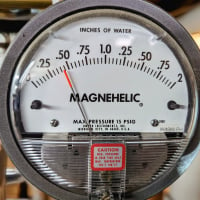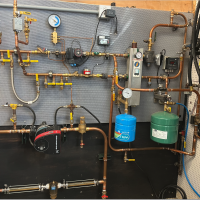Best Of
Re: How to size my Circulator pump ?
The location of the manifold or the boiler or the radiators do not affect the head requirements. the only thing that pump is looking at is the friction of the piping walls. that is what the pump needs to overcome.
I thing you will get a good idea of how this works if you read pages 7 and 8 of this booklet.
https://s3.amazonaws.com/s3.supplyhouse.com/product_files/108119-Reference%20Guide.pdf
Re: Old oil furnace nozzle compatibility
What burner is on that furnace?
The label tells us a few things:
1- the firing rate is 1.10 gallons per hour (GPH);
2- the spray angle is 80 degrees;
3- the spray pattern is "R". This was probably a Monarch nozzle with a solid spray pattern. We don't see Monarchs much anymore, but there is a cross-reference here on page 21:
So, assuming this is correct, the replacement would probably be a Delavan 1.10x80B. BUT……..
This must be verified by a competent service person having the proper tools (flame mirror, combustion analyzer etc) and the proper know-how.
Looks like you're in Canada. This site has a "Find a Contractor" page, but it doesn't go to the Great White North.
Re: When to NOT use sharkbite? A question
i'd sweat on an npt adapter or a union and figure out how to preassemble the rest or just flare it or use a compression fitting.
or pex with expansion fittings from the adapter
Re: Confused - Hydronic air handler VS heat pump VS heat pump plus furnance
"Does this mean I need to now ensure I seal the crawl space and separately run mini splits in both the basement and crawl space?"
No you do not need to condition the basement or the crawlspace. That is going to happen partially anyway. Just for example, I did a Central Air Conditioner for a customer In Brigantine NJ after Hurricane Sandy. FEMA dollars allowed them to lift their home from the ground so that the crawl space went from 2.5 ft off the ground to over 8 feet off the ground. As a result, they ended up with a very convenient place to install ductwork. It was still considered a crawl space as there was a dirt floor. After that work was completed they wanted to have the Central Air installed in the attic, just like everyone else does. This means that the new ductwork would be located in the attic and it would be operating when the attic could reach temperatures exceeding 115° in the midday with the sun beating on that roof. So I offered them a 3.5 ton cooling system but I also offered them a 3 ton system where the indoor unit would be located in the 8ft+ tall crawl space. The reduction in size was a result of installing the ductwork in a much more friendly temperature location. Two things happened with this option. The cost of the installation was about 8% lower, but more importantly, the operating cost was also reduced for as long as they owned that home. A 6,000 BTU Smaller compressor will use less electricity for as long as that compressor is operational.
Eventually they upgraded to a Gas Furnace in the Crawlspace. That added a small amount of heat to the space under the home. That heat that warmed the space under the home was not a perceived loss as their floors were warmer in the winter which made for an overall higher level of comfort in their home. So selecting the ductwork location for your heat pump is an important decision. Don't just do the easiest thing and put the second floor ductwork in the attic. See if you can install it within the envelope of your conditioned space and add soffits to cover them. That is a better design, although it may not look the best.
Why none of my competitors didn't offer them the lower duct work job still makes me wonder.
Hope this answers your query.
Re: When to NOT use sharkbite? A question
If it's not vacuum breaker, frostproof and quarter turn I don't consider it worth repairing.
Re: How to Install a Toilet? Step-by-Step Advice
The OP's email address was flagged for frequent spamming and linked to a plumbing company. I'd hope they'd know how to install a toilet. They were likely going to wait until the thread sunk a bit and then edit their initial post with a link to their company. A known tactic. We try to be as proactive as possible to prevent this sort of spam. Thanks. - Andrew
Re: Your favorite Heating Help questions
" What kind of pipe dope do I use"
Is my all time favorite.
It makes me want to scream.
Re: When to NOT use sharkbite? A question
Sharkbite is the easiest type of connect to disconnect, the only thing that comes close is threaded brass. So I like them for places that are likely to be disconnected.
Sillcocks fail all the time. If you get one with a copper sweat or PEX-B connection the pipe tail will be smaller than the body of the valve and will easily go into any hole that the valve fits in. If you put a Sharkbite as the first fitting on the inside of the wall it becomes a five minute job to switch it out.
The kicker is that almost certainly the replacement sillcock is going to have slightly different dimensions than the one that was in there. With a Sharkbite all you have to do is adjust the length of the tail piece of PEX or copper. You can even cut it long, attach it, measure on the outside how much too long it is, then disconnect it and trim to length. Easy-peasy.
If the inside of the sillcock is exposed I like to have a Sharkbite quarter turn shutoff valve as the first fitting inside the wall.
Re: Confused - Hydronic air handler VS heat pump VS heat pump plus furnance
Did you install a furnace and ductwork in a location that could still flood?
If the house was raised 8', I would assume that was decided to get it above the highest expected flood level, no?
 ChrisJ
ChrisJ
Re: DHW Check valves
Swing checks sometimes get used as an over-heat protection valve on wood boilers. In this example the check is intended to stop reverse thermosiphoning.
Also if power goes out the hotter, higher buoyancy water will crack open the swing check enough to allow thermosiphoning. Same concept as a gravity hydronic heating system, movement caused by ∆T
So a swing check on an application with a thermal differential, may in fact not be checking.
Not an easy thing to calculate when a swing check cannot do it's job, really. A swing check really likes to see higher pressure on the downstream side to close and seal. A sewage lift pump is a good application for a swing check. High flow rate, can handle small solids.
If positive, bubble free check protection is what you want or need, go with a spring assist type check.
So that is why you want to know specifically what the check is expected to do.
 hot_rod
hot_rod



